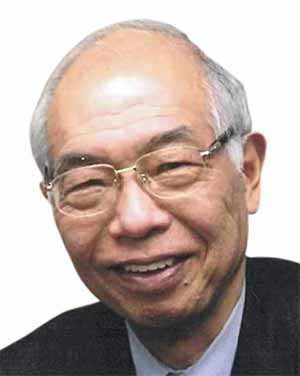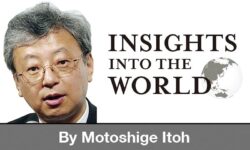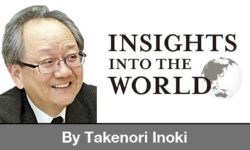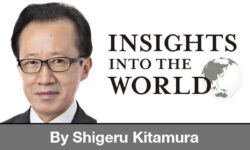14:47 JST, April 21, 2022
While we are still uncertain about how soon the novel coronavirus pandemic will end, worrisome data has been released.
Japan’s National Cancer Center reported that the number of people in Japan who were newly diagnosed with and treated for cancer in 2020 decreased by about 60,000 from the previous year — a sharp year-on-year decline of nearly 5%.
The annual total of cases of new cancer diagnosis and treatment had been gradually increasing in the preceding years. Therefore, it is hard to know why the number of new cancer patients suddenly shrank in 2020. COVID-19 infections seem to have forced the suspension of cancer screenings and caused people to regard seeing doctors as a “nonessential, nonurgent” activity they therefore should refrain from.
Needless to say, the most important point in cancer medicine is early diagnosis and treatment. As a person who has fully devoted himself to seeking to eradicate cancer, I cannot overlook the fact that so many people missed opportunities for early diagnosis and treatment.
The coronavirus pandemic continues shaking the fundamentals of the cancer medicine system — which has been built up through decade upon decade of assiduous efforts — to the extent that cancer patients’ lives are being threatened.
Now is the time for me to reaffirm what the efforts toward cancer eradication have achieved to date and bring fresh thinking to what should be done further in the future.
This year, Japan marks the 15th anniversary of implementing the Cancer Control Law — an epoch-making development in which cancer patients’ voices seeking better treatment finally had politics act in their favor.
With the enforcement of the basic law for cancer control in April 2007, the government launched a council on the Basic Plan to Promote Cancer Control Programs.
Basic law prompts progress
The basic law stipulates that the council includes members representing cancer patients, their families or bereaved ones. If the past practice had been adhered to, the council would have been comprised only of cancer medicine specialists and similar experts. When the council held its inaugural meeting in April 2007, four of its 18 members represented cancer patients, their families and bereaved ones.
The council worked on first-phase basic programs, covering the period from fiscal 2007 to fiscal 2011. The council’s secretariat proposed that it should aim to improve the quality of life (QOL) for all cancer patients.
In response, the members representing cancer patients’ families and bereaved ones said: “Patients have hard times, of course, but their family members have equally hard or even harder times. So we want [measures for] QOL improvement to cover families as well.” As a result, the council unanimously changed the proposal to aim to “improve the QOL for cancer patients and their families.”
Then, the purpose of Japan’s cancer medicine was set to create a system in which medical staff, among others, would focus on supporting both cancer patients and their families. This was a significant step forward.
The basic programs included a goal of reducing the death rate from cancer by 20% over a 10-year period and plans to designate core hospitals for cancer treatment. The cancer mortality rate consequently decreased by 16% with the five-year survival rate among patients improving. There is no doubt that Japan’s cancer control has made great progress thanks to the legislation.
Levels of medicine availability change as time goes by. The Basic Plan to Promote Cancer Control Programs, which is the country’s overall strategy for cancer control, has so far been revised twice.
When the second-phase basic programs were adopted for fiscal 2012-16, the relevant measures were quite elaborate, reflecting opinions of cancer patients and their families.
Those measures, for example, included one to facilitate employment of cancer patients.
While it is excellent news that advances in medicine have extended the survival rate of cancer patients, such improvement is associated with a new challenge — an increase in the number of cancer patients with no job opportunities.
A health ministry research team found that, of those employees diagnosed with cancer, 30% tendered letters of resignation while 4% were dismissed. The basic plan then incorporated a new policy designed to ensure that workplaces have a correct understanding about cancer and set up a system to provide relevant consultation services.
Even today, cancer patients have trouble continuing employment while receiving treatment. The basic plan must strengthen and improve the existing measures further to help such patients.
The ongoing third phase of the basic plan, covering fiscal 2017-22, includes measures for adolescent and young adult (AYA) cancer patients, ages 15 to 39, for the first time.
Cancer tends to be considered a disease affecting middle-aged and older people. Little attention seems to be paid to cancer patients in the AYA generation, as they exist between the older and younger ones.
AYA cancer patients are at a sensitive age or at major turning points in their life, ranging from going on to the next stage of education to finding employment, marrying and having children. As such, they are apt to feel mentally unstable. In the earlier years after the basic law was implemented, more than a few AYA cancer patients were unable to receive adequate care, as no system was in place yet to provide organized support to them.
Against this background, the current phase of the basic plan requires the state to be responsible for introducing a system dedicated to giving medical and employment support to cancer patients in the AYA generation. Cancer is a disease that must be eradicated as it affects people regardless of age or sex.
Measures in foreign countries
Now, let’s look at related measures taken in foreign countries. In the United States, then President Richard Nixon signed into law the National Cancer Act of 1971. For 50 years now, various sectors in the United States have steadily promoted measures against smoking, enhanced cancer screening, emphasized the importance of cancer research, advanced cancer care and spread palliative care services, among other efforts.
In 2016, then U.S. Vice President Joe Biden, the current president, led the Cancer Moonshot effort after losing his eldest son to brain cancer. Then President Barack Obama, gaining the cooperation of the National Cancer Institute of the United States, called for genomic science to be applied to cancer research and treatment to make the U.S. capable of curing cancer. In recent years, the death rate from cancer in the United States has been on the decrease.
In Britain, a national comprehensive cancer plan was introduced in 2000. On many points, the British plan resembles Japan’s Basic Plan to Promote Cancer Control Programs. Britain carried out a rigorous interim review of cancer service improvements in 2005, giving positive evaluations in many categories. In 2007, a similar review emphasized the need for providing more effective cancer services, including having patients stay in the hospital for shorter periods and improving cost-effectiveness.
Japan’s cancer control strategy is comparable to those of the United States and Britain as it has been strongly implemented since the enactment of the Cancer Control Law.
Nonetheless, it should be noted that the third-phase basic plan has no explicit numerical target for reducing deaths from cancer. There are some who point out that Japan has not performed a rigid interim review of the basic plan. This can be a point that should be taken into consideration for improvement in the process of working out the fourth-phase basic plan scheduled to begin in fiscal 2023.
Currently, the spread of COVID-19 continues to draw people’s attention at home and abroad to infectious diseases. A survey conducted by the Japan Cancer Society found that the number of people receiving cancer screening programs organized by local governments in 2020 fell by a hefty 30% from 2019. The contraction means that cancer likely has gone undetected in an estimated 2,100 people.
The adverse effect of the sharp decrease in the number of people receiving cancer screening will become apparent from now on. In other words, we are in a situation where we may inevitably find it too late to do anything to cure cancer in many people. I hope the government will improve the situation as soon as possible.
In 2012, the Union for International Cancer Control (UICC), which is the largest private-sector cancer control organization in the world, called for multi-stakeholder partnerships and participation of a broad range of relevant professionals as a prerequisite for cancer prevention and control. I think the same way.
We need to formulate a framework for multi-stakeholder partnerships that will enable everyone — not only medical specialists and experts as well as cancer patients and their families, but also businesses and ordinary citizens — to take part in cancer control campaigns.

Tadao Kakizoe
Kakizoe is president of the Japan Cancer Society and a past president of the National Cancer Center.
"Editorial & Columns" POPULAR ARTICLE
-

Violations of Subcontract Law: Major Automakers Must Eliminate Old Practices
-

Local Governments’ Tax Revenues: Devise Ways to Correct Imbalances in Tax Sources
-

5 Japanese Business Dinner Mistakes to Avoid — and What They Taught Me About Business in Japan
-

Heavy Rains in Asia: Support for Victims, Flood-Control Measures Urgently Needed
-

Rice Coupons: A Misguided Approach to Countering Rising Prices
JN ACCESS RANKING
-

Keidanren Chairman Yoshinobu Tsutsui Visits Kashiwazaki-Kariwa Nuclear Power Plant; Inspects New Emergency Safety System
-

Imports of Rare Earths from China Facing Delays, May Be Caused by Deterioration of Japan-China Relations
-

University of Tokyo Professor Discusses Japanese Economic Security in Interview Ahead of Forum
-

Japan Pulls out of Vietnam Nuclear Project, Complicating Hanoi’s Power Plans
-

Govt Aims to Expand NISA Program Lineup, Abolish Age Restriction
























